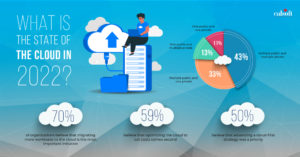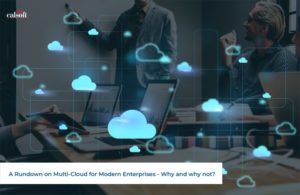In August 2021, Gartner predicted that end-user spending on cloud services would increase from $396 billion to $482 billion by 2022. Based on the rising adoption of cloud business processes, infrastructure, and application services, this forecast is very much in line with what we are seeing today. More and more organizations are looking to leverage hybrid cloud solutions for their digital transformation initiatives.
One of the most obvious approaches to this adoption has been to replace legacy applications with cloud-native ones. Of course, several advantages such as reduced capital costs, improved operational efficiency, faster time to market, and increased agility have driven this trend.
A survey by Harvard Business Review Analytic Services outlines that:
—almost 50% of the organizations endeavoring to adopt cloud services look to replace legacy systems
—42% prefer re-modifying the application interaction with datacenters
—26% find it favorable to refactor the internal code to achieve desired cloud integration
—only 17% consider rebuilding applications from scratch by leveraging containers and serverless architectures
Indeed, the paths to cloud adoption are many, and so are the drivers pushing the adoption of different cloud formats and options. The reasons for the same are multifaceted. For instance, some enterprises want to keep away from vendor lock-in (which often translates into a higher cost of ownership), some outline security concerns around data privacy and compliance, while others point out the compatibility issues between traditional on-premise systems and public cloud environments.
Besides, the high degree of variability in both the technology stack and the existing deployment landscape makes implementation decisions difficult.
Hybrid Digital Infrastructure As the Answer
Hybrid cloud infrastructure can serve as the ideal solution to facilitate greater and deeper enterprise usage of cloud-based services. Here’s how:
- A mix of centralized and decentralized IT resources, which include application servers, database management systems, load balancers, firewalls, and so forth, which helps enterprises protect against threats and ensures secure access to critical applications. This also provides them with sufficient visibility into network performance to respond quickly when things get compromised or if any user gets locked out.
- As opposed to relying on a sole service provider, which may be unable to meet specific requirements in terms of capacity and/or flexibility, a hybrid approach allows enterprises to leverage multiple vendors’ capabilities.
- The hybrid infrastructure further facilitates the easy migration of workloads to different clouds based on dynamic demand and resource requirements, enabling more efficient utilization of resources within the core data center.
Certainly, the high payoff of a hybrid infrastructure is clear. And considering the invariably expanding set of complex conditions playing into the business landscape, its adoption is only going to increase.
The Latest Hybrid Digital Infrastructure Trends
The hybrid approach to IT infrastructure is gaining wider acceptance, and it’s not hard to see why. Here are some of the key trends that will shape the digital infrastructure landscape in the near future:
1. Hybrid Cloud’s Prominence
No surprises here; hybrid cloud is already the standard for most enterprises that leverage the cloud to accommodate increased workloads, data, and applications while ensuring high availability. With most enterprises looking to avoid vendor lock-in, they opt for flexible solutions to support a multi-cloud strategy and are not limited to a single cloud provider.
“Most companies are addressing the desire to work through the cloud without exposing certain data to the risk of exposure by turning to a hybrid model of public and private cloud operations,” suggest Accenture’s lead strategists Bhaskar Ghosh and Karthik Narain. Unsurprisingly, the discussion on the means to secure sensitive information while managing and controlling how it is accessed and by whom continues to engulf enterprises. This is precisely why hybrid cloud strategies are gaining more ground in the digital infrastructure landscape.
2. DevSecOps Prowess
The advent of DevSecOps has driven organizations to focus on building more secure software by bridging the gap between development and security. Agile security that can move at the speed of business is vital. For most enterprises, this hybrid approach to IT infrastructure allows them to leverage the benefits of both agility and security.
This translates to security being built into the application development lifecycle and being a starting point for the delivery of secure, reliable, and high-performing applications. The hybrid digital infrastructure empowers enterprises to ensure that compliance is enforced across their application delivery environment. Hence, they can meet their security regulations while speeding up development cycles.
3. Silo Dissolution
“As organizations continue to rebound and pivot following the coronavirus crisis, ‘data silos’ could soon be a ubiquitous term,” asserts Michael Paladino, a Forbes Council Member. Data silos have always been a problem for organizations, especially in the context of legacy systems being bound to their specific on-premise infrastructure.
As the need for agility grows, enterprises are looking to adopt new and innovative ways to accelerate their data-driven applications. Hybrid infrastructure offers a solution to this problem, in the form of seamless integration that enables an enterprise to develop data-driven applications, and securely extract, transfer and store data across external resources.
In fact, the adoption of hybrid cloud solutions can also be seen in the context of addressing the lack of standardization in IT infrastructure, and enhancing end-to-end process visibility to help enterprises with comprehensive insights about their performance.
Hybrid Digital Infrastructure Management (HDIM) – The Case for 2022
HDIM is enabling enterprises to gain visibility into the entire IT infrastructure, from within the data center and across multiple clouds. It is a logical evolution of the hybrid infrastructure, as it’s intended to support not only data centers but also IoT, industrial, retail, and consumer applications. As such, HDIM is rapidly emerging as a key enabler of the digital business paradigm.
According to more than 20% of organizations will enable HDIM tools, frameworks, and strategies by 2022. Strong growth, one may say, especially when it comes to the above-mentioned trends of the dynamic industry 4.0.







